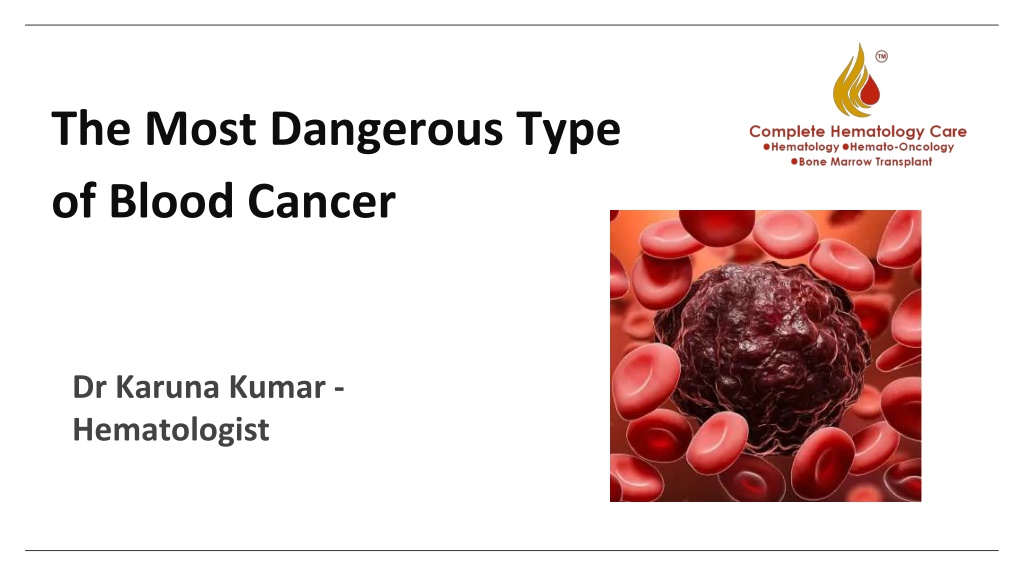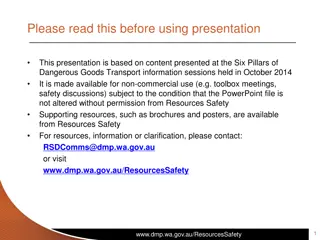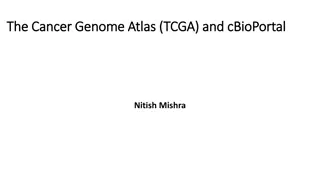Understanding the Most Dangerous Type of Blood Cancer - Dr Karuna Kumar
Learn about the most dangerous blood cancer: Acute Myeloid Leukemia (AML). Learn its symptoms, treatment challenges, and prognosis in this detailed guide. To know more: // /blog/which-type-of-blood-cancer-is-most-dangerous/
Uploaded on Jul 29, 2024 | 0 Views
Download Presentation

Please find below an Image/Link to download the presentation.
The content on the website is provided AS IS for your information and personal use only. It may not be sold, licensed, or shared on other websites without obtaining consent from the author. Download presentation by click this link. If you encounter any issues during the download, it is possible that the publisher has removed the file from their server.
E N D
Presentation Transcript
The Most Dangerous Type of Blood Cancer Dr Karuna Kumar - Hematologist
Content Introduction to Blood Cancer Types of Blood Cancer Acute Myeloid Leukemia (AML) Symptoms of AML Diagnosis of AML Treatment Challenges for AML Prognosis and Survival Rates Other Dangerous Blood Cancers
Overview Introduction to Blood Cancer Blood cancer refers to a group of malignancies that affect the blood, bone marrow, and lymphatic system, disrupting the production and function of blood cells. The lymphoma, and myeloma, each with distinct characteristics and health implications. These cancers can lead to severe complications by impairing the body's ability to produce healthy blood cells, which are essential for oxygen transport, immune defense, and overall bodily function. three main types of blood cancer are leukemia, The impact of blood cancer on health can be profound, often resulting in symptoms like fatigue, infections, and bleeding disorders that significantly affect a patient's quality of life.
Overview Types of Blood Cancer Leukemia Lymphoma Myeloma Lymphoma system, which is integral to the immune system. It includes Hodgkin lymphoma, marked Sternberg cells, and non-Hodgkin lymphoma, which encompasses a diverse group of cancers. affects the lymphatic Myeloma is a cancer of plasma cells in the bone marrow, leading to an overproduction of abnormal plasma cells. The most Multiple Myeloma, can cause bone pain and kidney issues. Leukemia is a cancer of blood- forming tissues, leading to the overproduction of abnormal white blood cells. It is classified into acute and chronic forms, affecting both children and adults. by Reed- common type,
Most Dangerous Blood Cancer Acute Myeloid Leukemia (AML) Characteristics of AML Symptoms of AML Danger Level of AML Acute Myeloid Leukemia is Common symptoms include AML is considered the most marked by the rapid proliferation of fatigue, frequent infections, easy dangerous type of blood cancer due abnormal myeloid cells in the bone bruising, and bone pain, which to its swift progression, high relapse marrow and blood, leading to a develop quickly and severely impact rate, and complex treatment decrease in healthy blood cells. health. requirements.
Symptoms of AML Fatigue and Weakness: Patients often experience extreme tiredness due to anemia caused by a low red blood cell count, impacting daily activities. Frequent Infections: A low white blood cell count compromises the immune system, making patients more susceptible to infections. Easy Bruising and Bleeding: Low platelet counts can lead to easy bruising and prolonged bleeding from minor injuries. Bone and Joint Pain: Accumulation of cancer cells in the bone marrow can cause significant discomfort and pain in the bones and joints. Weight Loss and Loss of Appetite: A common symptom in many types of cancer, patients may experience a notable decrease in appetite and subsequent weight loss.
Diagnosis Diagnosis of AML Blood Tests Blood tests are conducted to evaluate levels of white blood cells, red blood cells, and platelets. Abnormal counts may indicate leukemia. Bone Marrow Biopsy A bone marrow biopsy involves extracting a sample from the bone marrow to check for the presence of abnormal cells. This helps confirm a diagnosis of AML. Genetic Tests Genetic testing identifies specific mutations in cancer cells, which can influence treatment decisions and prognosis. These tests help tailor therapy to the individual's cancer profile.
Blood Cancer Treatment Challenges for AML Intensive Chemotherapy Stem Cell Transplant Targeted Therapy Chemotherapy is the primary A stem cell transplant may be New treatments focus on specific treatment for AML, targeting rapidly necessary for younger patients or genetic mutations in AML cells, dividing cancer cells. However, it those with high-risk AML. This improving treatment effectiveness also damages healthy cells, leading to procedure requires high-dose while often reducing side effects severe side effects such as nausea, chemotherapy to eliminate cancer compared to traditional hair loss, and increased infection cells but poses challenges in finding a chemotherapy. However, access and risk. compatible donor. affordability can be significant barriers.
Prognosis Prognosis and Survival Rates 27% Overall 5-Year Survival Rate 60% Survival Rate for Younger Patients Varies Impact of Genetic Mutations 10% Survival Rate for Older Adults
Blood Cancer Types Other Dangerous Blood Cancers Acute Lymphoblastic Leukemia (ALL) ALL is an aggressive form of leukemia that primarily affects lymphoid cells. It progresses rapidly, requiring immediate treatment to improve outcomes. Commonly diagnosed in children, but can also occur in adults. Diffuse Large B-cell Lymphoma (DLBCL) DLBCL is a fast-growing subtype of non-Hodgkin lymphoma. It can be life-threatening if not treated promptly. Symptoms may include swollen lymph nodes, fever, and night sweats.
Reference. 1. Which Type of Blood Cancer Is Most Dangerous? Our Address Dr KK Hematology Clinic No 3-9-242, 81, Siva Arun Colony, West Marredpally, Secunderabad, Telangana 500026 Mon to Sat - 06:00pm 09:00pm Closed on Thursday & Sunday Dr Karuna Kumar MD DNB Hematologist Hemato-Oncologist & Bone Marrow Transplant Physician (+91)97427 78093

























